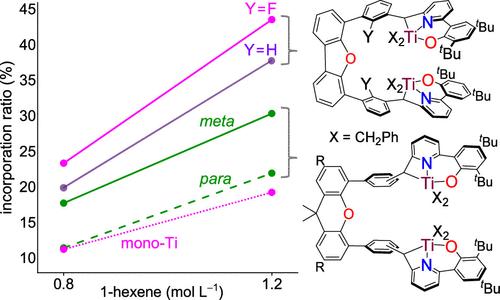几何约束共面双钛烯烃聚合催化剂:调节和提高共聚单体掺入密度
IF 11.3
1区 化学
Q1 CHEMISTRY, PHYSICAL
引用次数: 0
摘要
本文介绍了一系列具有刚性连接体成分(呫吨或二苯并呋喃)的形状持久的双[C(sp3)-螯合]Ti2(加上 Zr2 和 Hf2)配合物。这些结构各异的组合体显示出有限但不同的构象灵活性,而且至关重要的是,这种几何约束赋予了金属间分离和定向的范围,从而有可能提高催化活性和合作效应。在乙烯聚合反应中,Ti2 催化剂(与硼酸三甲苯酯配合使用)比单核催化剂具有更高的效率,并能生成具有更高密度值的聚合物,考虑到共面双金属位点的环境更为拥挤,这一点意义重大。在乙烯-(α-烯烃)共聚反应中观察到 1-己烯的充分掺入。核磁共振分析表明,F 取代的间位芳基/二苯并呋喃连接催化剂 (5) 在构象上与其不含 F 的同系物不同,与单钛对照组(19%)相比,该催化剂产生的共聚物具有更高的 Mw 和更高的 1-己烯掺入水平(高达 44%)。这些结果表明,具有适当可调构象和钛-钛距离的催化剂框架可以促进与 α 烯烃基质的双金属链相互作用及其插入。本文章由计算机程序翻译,如有差异,请以英文原文为准。

Geometrically Constrained Cofacial Bi-Titanium Olefin Polymerization Catalysts: Tuning and Enhancing Comonomer Incorporation Density
A series of shape-persistent bis-[C(sp3)-chelating] Ti2 (plus Zr2 and Hf2) complexes with a rigid linker component (xanthene or dibenzofuran) are presented. These structurally diverse assemblies display limited yet different conformational flexibility, and crucially, such geometric constraints confer access to a range of intermetallic separations and orientations to potentially enhance catalytic activity and cooperative effects. For ethylene polymerizations, the Ti2 catalysts (in conjunction with trityl borate) exhibit greater efficiencies and produced polymers with higher Mw than mononuclear controls, which is significant considering the more crowded environment for cofacial bimetallic sites. Proficient 1-hexene incorporations were observed for ethylene-(α-olefin) copolymerization reactions. The F-substituted m-aryl/dibenzofuran-linked catalyst (5), which is revealed by NMR analysis to be conformationally dissimilar to its F-absent congener, produced copolymers with higher Mw and elevated 1-hexene incorporation levels (up to 44%), when compared with its mono-Ti control (19%). These results suggest that catalyst frameworks with suitably adjustable conformations and Ti···Ti distances can facilitate bimetallic enchainment interactions with α-olefin substrates and their insertion.
求助全文
通过发布文献求助,成功后即可免费获取论文全文。
去求助
来源期刊

ACS Catalysis
CHEMISTRY, PHYSICAL-
CiteScore
20.80
自引率
6.20%
发文量
1253
审稿时长
1.5 months
期刊介绍:
ACS Catalysis is an esteemed journal that publishes original research in the fields of heterogeneous catalysis, molecular catalysis, and biocatalysis. It offers broad coverage across diverse areas such as life sciences, organometallics and synthesis, photochemistry and electrochemistry, drug discovery and synthesis, materials science, environmental protection, polymer discovery and synthesis, and energy and fuels.
The scope of the journal is to showcase innovative work in various aspects of catalysis. This includes new reactions and novel synthetic approaches utilizing known catalysts, the discovery or modification of new catalysts, elucidation of catalytic mechanisms through cutting-edge investigations, practical enhancements of existing processes, as well as conceptual advances in the field. Contributions to ACS Catalysis can encompass both experimental and theoretical research focused on catalytic molecules, macromolecules, and materials that exhibit catalytic turnover.
 求助内容:
求助内容: 应助结果提醒方式:
应助结果提醒方式:


